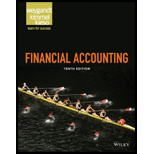
Concept explainers
1.
Statement of
Statement of Cash Flows is a financial statement that shows the cash and cash equivalents of a company for a particular period of time. It determines the net changes in cash through reporting the sources and uses of cash due to operating, investing, and financial activities of a company. Statement of cash flows shows all the receipts and payments that are made in a specific period of time.
The cash flow statement is categorized into three parts as follows:
- Cash flow from operating activities:
All those activities that are related to production, sales, and delivery of an organization’s product or service and collection of payments from customers come under this category. For example: Losses, gains, purchase of raw material, inventory,
depreciation , and advertising. - Cash flow from investing activities:
When an organization purchases or sells any asset, then whatever cash comes in or goes out are reported under this head of the cash flow statement. If any loan is made to a supplier or received from a customer then, it would be reported in it and if a merger or acquisition exists there, then all the payments related to it would also be recorded in it.
- Cash flow from financing activities:
The inflow of cash from investors like bank and shareholders and outflow to shareholders in the form of dividends is recorded under this head of the cash flow statement. All those activities that affect the long-term liabilities or equity of the organization will also be reported under this head.
Identify the transaction as an operating, investing, or financing activity.
2.
Identify the transaction as an operating, investing, or financing activity.
3.
Identify the transaction as an operating, investing, or financing activity.
4.
Identify the transaction as an operating, investing, or financing activity.
5.
Identify the transaction as an operating, investing, or financing activity.
6.
Identify the transaction as an operating, investing, or financing activity.
7.
Identify the transaction as an operating, investing, or financing activity.
Want to see the full answer?
Check out a sample textbook solution
Chapter 1 Solutions
Financial Accounting

 AccountingAccountingISBN:9781337272094Author:WARREN, Carl S., Reeve, James M., Duchac, Jonathan E.Publisher:Cengage Learning,
AccountingAccountingISBN:9781337272094Author:WARREN, Carl S., Reeve, James M., Duchac, Jonathan E.Publisher:Cengage Learning, Accounting Information SystemsAccountingISBN:9781337619202Author:Hall, James A.Publisher:Cengage Learning,
Accounting Information SystemsAccountingISBN:9781337619202Author:Hall, James A.Publisher:Cengage Learning, Horngren's Cost Accounting: A Managerial Emphasis...AccountingISBN:9780134475585Author:Srikant M. Datar, Madhav V. RajanPublisher:PEARSON
Horngren's Cost Accounting: A Managerial Emphasis...AccountingISBN:9780134475585Author:Srikant M. Datar, Madhav V. RajanPublisher:PEARSON Intermediate AccountingAccountingISBN:9781259722660Author:J. David Spiceland, Mark W. Nelson, Wayne M ThomasPublisher:McGraw-Hill Education
Intermediate AccountingAccountingISBN:9781259722660Author:J. David Spiceland, Mark W. Nelson, Wayne M ThomasPublisher:McGraw-Hill Education Financial and Managerial AccountingAccountingISBN:9781259726705Author:John J Wild, Ken W. Shaw, Barbara Chiappetta Fundamental Accounting PrinciplesPublisher:McGraw-Hill Education
Financial and Managerial AccountingAccountingISBN:9781259726705Author:John J Wild, Ken W. Shaw, Barbara Chiappetta Fundamental Accounting PrinciplesPublisher:McGraw-Hill Education





